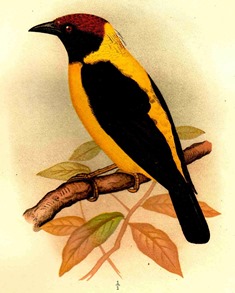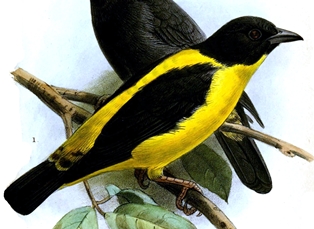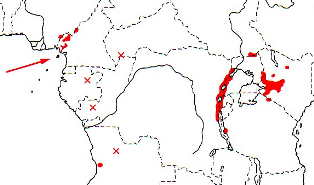Weaver Wednesday [78]: Brown-capped Weaver 2013-12-11 (460)
 Weaver Wednesday
Weaver Wednesday


The Brown-capped Weaver Ploceus insignis is one of the 'nuthatch' (bark-gleaning) weavers, the others being Sao Tome Weaver, Preuss's Weaver, Bar-winged Weaver, Usambara Weaver and Olive-headed Weaver. The Brown-capped Weaver has a yellow body with plain black wings and tail. The male has a black face and throat with a chestnut crown and nape. The female has the entire head black. The similar Preuss's Weaver has a chestnut wash on the breast and its female has a yellow crown. The Yellow-capped Weaver differs from the Brown-capped Weaver in having a black rump.

The Brown-capped Weaver occurs in scattered localities in West Africa from Nigeria to Angola. It also occurs along the Albertine Rift and in East Africa, especially western Kenya (see map left, based on Birds of Africa). Its distribution is very patchy, but is still widely distributed, but is uncommon in Angola and Gabon. Several subspecies of the Brown-capped Weaver have been described but are no longer recognised.
The Brown-capped Weaver inhabits tall montane forest, a vulnerable habitat type. It also occurs in bamboo forest, secondary forests, gallery forest and coffee plantations. It is often found in areas with an open canopy and dense understorey vegetation.
The Brown-capped Weaver feeds mainly on insects, such as caterpillars, and fruit. It moves at all levels in forests, hopping along boles and thicker lateral branches in the canopy. The The Brown-capped Weaver probes exposed bark and epiphytes with its bill. It feeds solitarily, in pairs, or in family parties of three or four individuals; it also joins mixed-species flocks.
The Brown-capped Weaver is probably monogamous, and is a solitary nester. The male uses a short courtship song away from the nest, and also sings when the female enters the nest. The nest is retort-shaped, and has a long entrance tube. The nest is attached to the underside of a branch or at the tip of a branch, often above a forest track or clearing. The clutch is 2 eggs, which are pale blue with a few brown spots.
The Brown-capped Weaver has no PHOWN records (see PHOWN summary), and very little is known about its breeding habits. Submit any weaver nest records to PHOWN (PHOtos of Weaver Nests) via the Virtual Museum upload site.
PHOWN summary
Previous Wedn: Finn's Weaver
Full weaver species list
| 

 Weaver Watch
Weaver Watch


